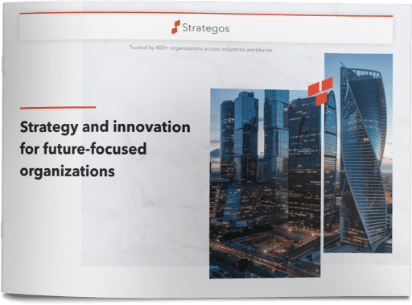At Strategos, when we talk with prospective clients the conversation almost always centers on one of three topics:
- The desire to create a differentiated competitive strategy
- The launch of an initiative to build a lasting “culture of innovation”
- The perceived need for “better ideas” to enable growth
Of course, all of these are completely valid goals! Helping clients with strategy, capability, and opportunities forms the foundation of our value proposition; and using a variety of novel insights about customers, capabilities, and external change drivers to identify a rich set of growth ideas is a core part of that.
But did you notice what’s missing? All too often, the goal of generating new ideas takes on a life of its own, divorced from the need to bring ideas to successful commercial realization.
And in instances in which companies have been working for a while to build innovation capabilities or culture, it can be all too easy to get stuck in Ideation Limbo – that place where lots of energy has been expended and great ideas generated, but over time enthusiasm starts to ebb as employees and executives begin to wonder when tangible business results will ever begin to be visible.
What’s Going On?
As we have reviewed a multitude of client experiences, we’ve identified a number of root causes of this phenomenon:
The desire to “start at the beginning.” It seems that humans like to work through processes from left to right, and the innovation process is no exception; it can seem almost unnatural to begin efforts somewhere in the middle of the opportunity life cycle.
- A sense that a company’s existing growth ideas aren’t good enough to merit development through what we call “late stage” innovation, the chain of activities that begins once an idea has first been identified and reaches through elaboration, experimentation, and execution.
- A belief on the part of companies that “we are good at implementation.” While this may be true of execution of well-practiced habits within the core operation, it’s actually surprising how bad companies are at executing even modest adjacencies.
- An eagerness to “get our people involved” and a belief that the easiest way to do this is by engaging them in idea creation. This seems to be particularly true when culture change is an explicit part of the company’s goal and executives view results as secondary to the objective of stimulating buzz.
- Confusing invention, the creation of new ideas, for innovation – the identification and application of ideas to yield a commercial result.
- Inattention to the creation of a “demand function” for the ideas generated by early-stage efforts. For innovation to work, the policies, processes, and infrastructure to enable the free flow of ideas to realization need to be in place, and executives need to have clear motivations to pull new ideas through the pipeline; too often, these are absent and the result is a large number of ideas with nowhere to go.
- For better or worse, the messages received from innovation consultancies over the years; from design thinking seminars to innovation jams to idea-market software, there’s a great deal out there about early-stage innovation but much less about converting ideas to impact.
In many cases, the result of all of the above is that as they execute innovation programs, companies violate what we might call the Law of Innovation Entropy. In its simplest form, the idea here is that there are two sources of energy that sustain a company’s innovation change efforts: the natural enthusiasm of employees as they become engaged in innovation, and the positive business outcomes that result. The “entropy” part is that this energy is constantly dissipating and will vanish completely if not constantly replenished.
As time elapses, the storehouse of employee (and executive) enthusiasm is not infinite: if as an employee you’ve contributed a great idea but it seems to go nowhere, or if from a corporate perspective the innovation program seems to be a matter of lots of talk and no results, the insidious Law of Innovation Entropy will inevitably drain the life out of your efforts.
So What Can You Do?
We’re certainly not the first to notice the ideation-execution gap, but our in-depth experience over the past 20 years has given us a number of insights into what you can do to ensure that you are achieving results:
- Balance early-stage discovery and idea generation with a healthy dose of late-stage idea improvement, experimentation, and commercialization.
- At the margin, consider taking a leap of faith and beginning your innovation change program with late-stage challenges that convert ideas to near-term business impact while building employee skills. We’re actually recommending this route more and more these days as a possible starting point for comprehensive embedment of innovation capabilities; once a few success stories are in hand, it becomes easier to go back to “the beginning” and launch a journey of early-stage discovery of new opportunity spaces.
- Give the late-stage process a better chance of success by establishing clear executive metrics that drive demand for innovation ideas, along with the supporting infrastructure such as seed funds and innovation coaching that are needed to pull ideas through the pipe.
- Apply what we call Agile Commercialization approaches to free new ideas from the constraints of traditional stage-gate models (more details on this coming soon in another article, so stay tuned!)
- Turn small ideas into big ones and collections of ideas into opportunity domains. While it is often true that a company’s stockpile of new offering or internal improvement ideas consists mostly of incremental thoughts, techniques like the Strategos Action Lab provide a way of stretching small starting points into more powerful business concepts. And by grouping related ideas into larger domains that are organized around a common customer or stakeholder benefit, companies can mobilize resources behind big opportunity spaces rather than depending on the validity of single, often small, starting ideas.
- Finally, don’t abandon the need to conduct early-stage discovery and idea generation as well! Strategos’ proprietary Discovery Lenses and idea generation approaches have been widely-implemented and much-imitated over the years for a reason – they do work, and play a critical role in expanding the portfolio of innovative growth opportunities.
Over the years, whether it’s been the GameChanger program at Shell, Korean communications company KT’s stream of Late-Stage Challenges, or our joint work now underway at a leading consumer packaged goods company to implement a broad-based “Ideas to Impact” process, Strategos clients have found that late-stage is a great stage. As you think about your innovation model, and particularly if you are at the point of launching a comprehensive program to establish innovation as a competence in your organization, think carefully about the role that moving ideas to impact should play.
And, as always, feel free to call on us if you’d like to talk about how to make these concepts a reality in your organization.




